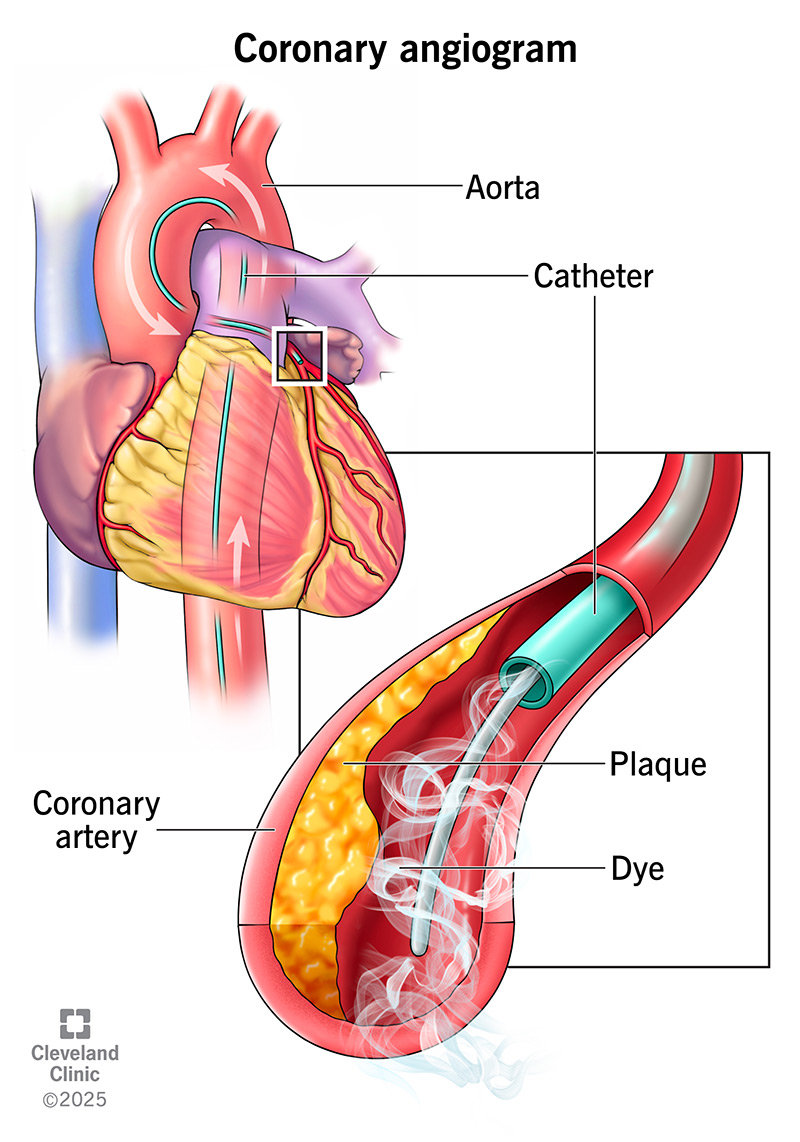A coronary angiogram can help your cardiologist look for blockages in your coronary arteries. X-ray images from the procedure will help your provider make a diagnosis. They’ll decide if you need medicine, a stent or surgery. Plan on spending a few hours at the hospital for the procedure and recovery.
Advertisement
Cleveland Clinic is a non-profit academic medical center. Advertising on our site helps support our mission. We do not endorse non-Cleveland Clinic products or services. Policy
A coronary angiogram is a test that uses X-rays and contrast dye to show how well your blood is moving in your coronary (heart) arteries. Your provider may also call this imaging test coronary angiography.
Advertisement
Cleveland Clinic is a non-profit academic medical center. Advertising on our site helps support our mission. We do not endorse non-Cleveland Clinic products or services. Policy
The test can show blockages in these arteries or if they’re narrowed — usually from atherosclerosis. Your coronary arteries are important because they get blood to your heart’s muscle. A blocked coronary artery can lead to a heart attack.
Your healthcare provider or cardiologist may recommend a coronary angiogram if:
Your provider will explain why they recommend this test. Don’t hesitate to ask questions.

Your healthcare provider will give you specific instructions for preparing for the test. They’ll also go over your medications and health history. In general, your provider will likely:
Advertisement
For your safety, you won’t be allowed to drive yourself home on the same day of the procedure. You should figure out transportation from the hospital if you’re going home the same day.
In general, you can expect the following during a coronary angiogram:
If the cardiologist sees something blocking your blood flow, they may be able to clear the blockage right away with a balloon. This is called an angioplasty. They can then then place a stent to keep your artery open.
If this isn’t possible or the cardiologist thinks a different procedure later is best, they’ll end the coronary angiogram.
A coronary angiogram typically takes 30 to 50 minutes. But this can vary.
When the procedure is done, the cardiologist will take out the catheter. A healthcare provider will put pressure on the site to stop or prevent any bleeding.
Most people can go home the same day — two to four hours after the coronary angiogram.
If your procedure was complex or you had it in the afternoon, you should be prepared to stay the night at the hospital.
You may feel tired after your coronary angiogram. Your wound may be sensitive or bruised for a week or more. Your provider may tell you to limit your activities for a couple of days after you get home.
It’s a good idea to get a coronary angiogram from a healthcare provider who does them often (at a high-volume center). Most of the time, they’re safe procedures. But they’re more invasive than other imaging tests, like an ultrasound. Serious complications are rare.
Advertisement
The risks of a coronary angiogram include:
You’re more likely to have complications if you:
Talk to your healthcare provider if you have questions about these risks.
You may be able to see your X-rays while the cardiologist does the test. Your provider will share what the results mean after your coronary angiogram is over.
Your cardiologist may describe your coronary angiogram results as normal or abnormal.
A normal result means nothing is blocking your coronary arteries. Your heart’s getting enough blood. If you still have symptoms, you may need other tests to get to the bottom of them.
With abnormal results, something may be blocking your coronary arteries. Your provider can tell you which arteries have a blockage and where. They can also explain the severity. They might use percentages to describe how blocked they are.
Advertisement
Your provider will explain what kind of treatment they recommend if the results are abnormal. This may include:
Contact your healthcare provider if you have any of the following at the site of the catheter placement:
You should also tell your provider if you have difficulty with circulation in your arms or legs.
Overall, a coronary angiogram should involve minimal pain. You may feel some temporary mild pain when:
You shouldn’t feel pain from the catheter during the procedure. You also won’t feel the provider threading the catheter through your blood vessels and arteries.
After the procedure, the sites where the IV and catheter went into your skin may be sore. But this should go away after a week or so.
Tell the provider immediately if you feel intense pain during any part of the procedure.
It can be stressful to hear you need a coronary angiogram. You may be worried you’ll get abnormal results. But the information your healthcare provider learns from your coronary angiogram will help them make a diagnosis and a treatment plan for you. Don’t hesitate to ask questions if there’s anything you don’t understand. Your provider’s there to help you.
Advertisement
When your heart needs some help, the cardiology experts at Cleveland Clinic are here for you. We diagnose and treat the full spectrum of cardiovascular diseases.

Last reviewed on 02/17/2025.
Learn more about the Health Library and our editorial process.